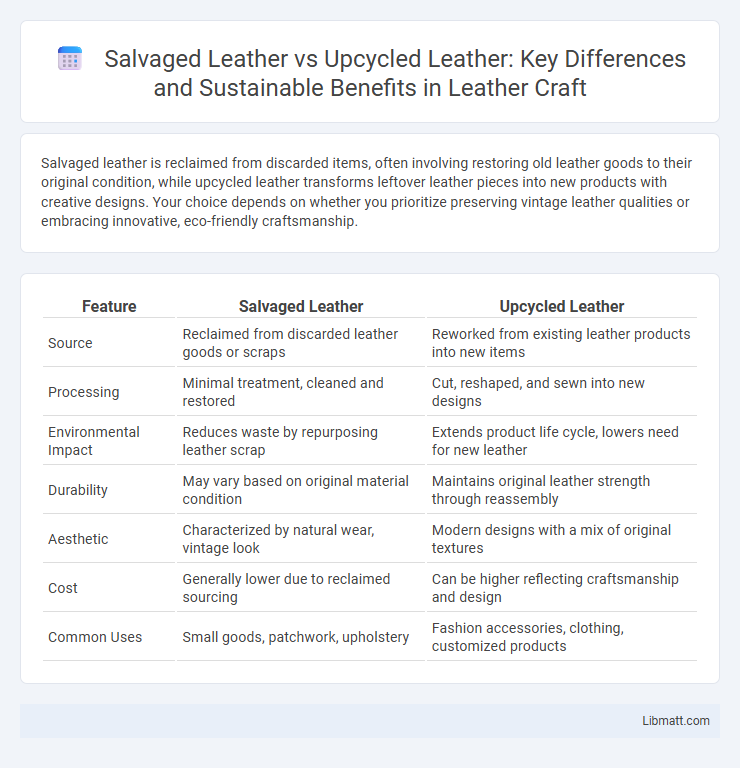Salvaged leather is reclaimed from discarded items, often involving restoring old leather goods to their original condition, while upcycled leather transforms leftover leather pieces into new products with creative designs. Your choice depends on whether you prioritize preserving vintage leather qualities or embracing innovative, eco-friendly craftsmanship.
Table of Comparison
| Feature | Salvaged Leather | Upcycled Leather |
|---|---|---|
| Source | Reclaimed from discarded leather goods or scraps | Reworked from existing leather products into new items |
| Processing | Minimal treatment, cleaned and restored | Cut, reshaped, and sewn into new designs |
| Environmental Impact | Reduces waste by repurposing leather scrap | Extends product life cycle, lowers need for new leather |
| Durability | May vary based on original material condition | Maintains original leather strength through reassembly |
| Aesthetic | Characterized by natural wear, vintage look | Modern designs with a mix of original textures |
| Cost | Generally lower due to reclaimed sourcing | Can be higher reflecting craftsmanship and design |
| Common Uses | Small goods, patchwork, upholstery | Fashion accessories, clothing, customized products |
Understanding Salvaged Leather
Salvaged leather refers to material reclaimed from discarded or damaged leather products, ensuring minimal waste by repurposing existing materials. Its unique texture and character result from previous use, offering an eco-friendly option that reduces the need for new raw leather production. Understanding salvaged leather helps your sustainable choices by highlighting how it preserves resources without compromising durability or style.
Defining Upcycled Leather
Upcycled leather refers to leather material that has been creatively repurposed from existing leather products or scraps, transforming waste into new, functional items without extensive reprocessing. Unlike salvaged leather, which often involves restoring old leather to its original state, upcycled leather incorporates design innovation to extend the life cycle of leather by giving it a fresh purpose. This sustainable approach reduces environmental impact by minimizing landfill waste and lowering the demand for new leather production.
Origins and Sourcing Methods
Salvaged leather originates from discarded or damaged leather goods, often sourced from manufacturing scraps, vintage items, or materials recovered from old furniture and vehicles. Upcycled leather involves transforming post-consumer leather products, such as old jackets or bags, into new, functional items through innovative design and crafting techniques. Understanding the distinct origins and sourcing methods helps you make eco-conscious decisions by choosing leather that reduces waste and promotes sustainability.
Environmental Impact Comparison
Salvaged leather involves reclaiming material from discarded leather products, reducing landfill waste and minimizing resource consumption during production. Upcycled leather transforms existing leather items by creatively altering or repairing them, extending product life and lowering the need for new raw materials. Your environmental footprint decreases more significantly with upcycled leather, as it maximizes the reuse of valuable leather without the energy-intensive processes often involved in salvaging and reprocessing.
Manufacturing Processes Explained
Salvaged leather is created by reclaiming discarded leather goods or scraps, which are carefully cleaned, reconditioned, and repurposed into new products, preserving the original material's integrity. Upcycled leather involves transforming existing leather items by altering their design or function, often combining different leather pieces to extend the product's lifecycle while reducing waste. Understanding these manufacturing processes helps you appreciate the environmental benefits and unique qualities of each type of sustainable leather.
Quality and Durability Differences
Salvaged leather, typically sourced from discarded leather goods, often undergoes minimal processing to preserve its original texture, resulting in high-quality material with natural durability. Upcycled leather involves repurposing leather scraps or lower-grade hides, which may be treated and reconstituted, potentially reducing its structural integrity compared to salvaged leather. Quality differences highlight that salvaged leather generally maintains superior resilience and longevity, while upcycled leather offers eco-friendly versatility with variable durability depending on the processing methods used.
Aesthetic and Design Variations
Salvaged leather features a rugged, distressed aesthetic characterized by its natural imperfections and vintage appeal, making each piece uniquely textured and ideal for rustic or industrial designs. Upcycled leather undergoes creative transformation, often combining different shades and patterns to produce innovative, eco-friendly designs that emphasize contemporary style. Your choice between these materials influences the final product's visual impact, from authentic authenticity in salvaged leather to artistic reinvention in upcycled leather.
Cost Factors and Market Value
Salvaged leather generally has lower cost factors due to its sourcing from discarded or waste materials, making it an affordable option for eco-conscious consumers. Upcycled leather involves more intensive processing and creative enhancement, which often increases its market value and appeals to niche markets seeking unique, sustainable products. Understanding these distinctions helps you make informed purchasing decisions based on budget and desired quality.
Popular Uses in Fashion and Decor
Salvaged leather, often sourced from reclaimed furniture and automotive interiors, is popular in fashion for artisanal handbags and rustic jackets due to its unique texture and durability. Upcycled leather, created by transforming discarded leather scraps, finds widespread use in trendy shoes, wallets, and eco-conscious home decor items like cushions and wall panels. Both materials appeal to sustainable fashion and interior design markets, offering stylish alternatives that reduce environmental impact.
Choosing the Right Option for Sustainability
Salvaged leather is sourced from discarded or surplus leather materials, reducing waste by repurposing existing hides, while upcycled leather involves creatively transforming old leather goods into new products, extending their lifecycle and minimizing environmental impact. Choosing between salvaged and upcycled leather depends on the desired sustainability goal: salvaged leather reduces raw material demand by utilizing excess production, whereas upcycled leather emphasizes innovation in design to prevent landfill contributions. Both options contribute to sustainable fashion by promoting resource efficiency and lowering the carbon footprint associated with traditional leather processing.
Salvaged leather vs upcycled leather Infographic

 libmatt.com
libmatt.com